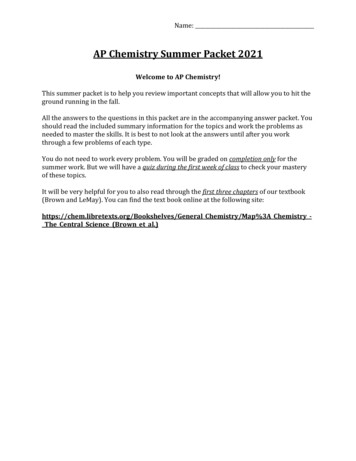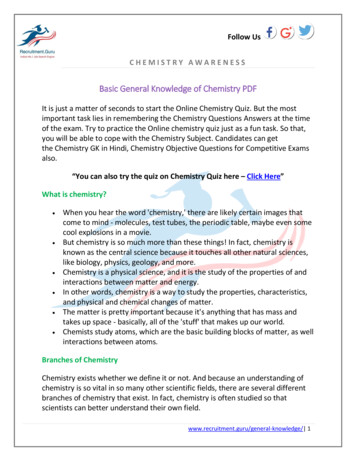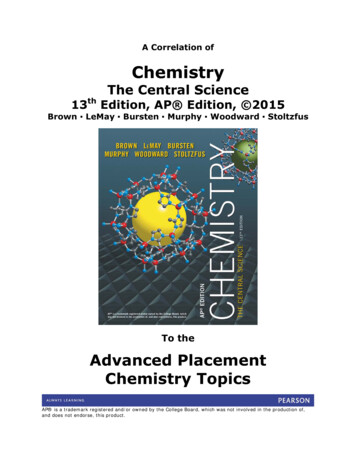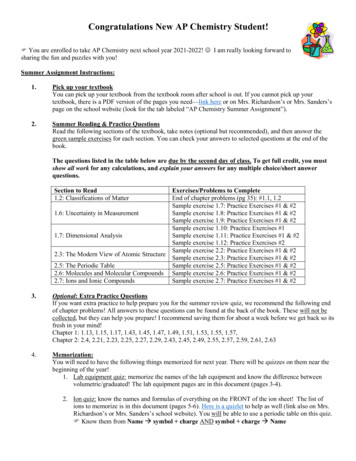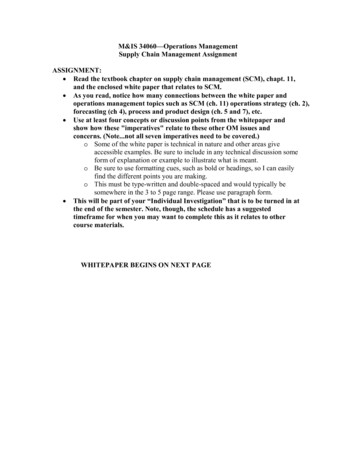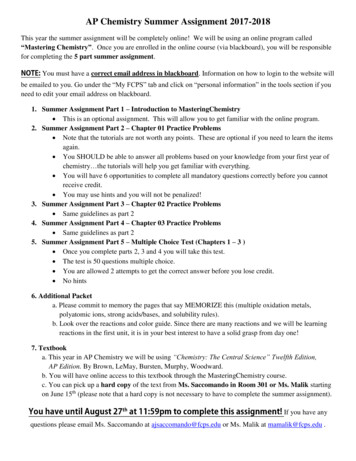
Transcription
AP Chemistry Summer Assignment 2017-2018This year the summer assignment will be completely online! We will be using an online program called“Mastering Chemistry”. Once you are enrolled in the online course (via blackboard), you will be responsiblefor completing the 5 part summer assignment.You must have a correct email address in blackboard. Information on how to login to the website willbe emailed to you. Go under the “My FCPS” tab and click on “personal information” in the tools section if youneed to edit your email address on blackboard.1. Summer Assignment Part 1 – Introduction to MasteringChemistry This is an optional assignment. This will allow you to get familiar with the online program.2. Summer Assignment Part 2 – Chapter 01 Practice Problems Note that the tutorials are not worth any points. These are optional if you need to learn the itemsagain. You SHOULD be able to answer all problems based on your knowledge from your first year ofchemistry the tutorials will help you get familiar with everything. You will have 6 opportunities to complete all mandatory questions correctly before you cannotreceive credit. You may use hints and you will not be penalized!3. Summer Assignment Part 3 – Chapter 02 Practice Problems Same guidelines as part 24. Summer Assignment Part 4 – Chapter 03 Practice Problems Same guidelines as part 25. Summer Assignment Part 5 – Multiple Choice Test (Chapters 1 – 3 ) Once you complete parts 2, 3 and 4 you will take this test. The test is 50 questions multiple choice. You are allowed 2 attempts to get the correct answer before you lose credit. No hints6. Additional Packeta. Please commit to memory the pages that say MEMORIZE this (multiple oxidation metals,polyatomic ions, strong acids/bases, and solubility rules).b. Look over the reactions and color guide. Since there are many reactions and we will be learningreactions in the first unit, it is in your best interest to have a solid grasp from day one!7. Textbooka. This year in AP Chemistry we will be using “Chemistry: The Central Science” Twelfth Edition,AP Edition. By Brown, LeMay, Bursten, Murphy, Woodward.b. You will have online access to this textbook through the MasteringChemistry course.c. You can pick up a hard copy of the text from Ms. Saccomando in Room 301 or Ms. Malik startingon June 15th (please note that a hard copy is not necessary to have to complete the summer assignment).If you have anyquestions please email Ms. Saccomando at ajsaccomando@fcps.edu or Ms. Malik at mamalik@fcps.edu .
Ionic Compounds (MEMORIZE THIS PAGE!)Common Metal Ions with More than One Ionic Charge (MOM)SymbolStock NameClassical Name CuCopper(I) ionCuprous ionCu2 Copper(II) ionCupric ion2 FeIron(II) ionFerrous ionFe3 Iron (III) ionFerric ion2 HgMercury(II) ionMercuric ion2 PbLead(II) ionPlumbous ionPb4 Lead(IV) ionPlumbic ion2 SnTin(II) ionStannous ionSn4 Tin(IV) ionStannic ion2 CrChromium(II) ionChromous ionCr3 Chromium(III) ionChromic ion2 MnManganese(II) ionManganous ion3 MnManganese(III) ionManganic ionCo2 Cobalt(II) ionCobaltous ionCo3 Cobalt(III) ionCobaltic ion***Note Silver ion and Zinc ion and Cadmium ion are all transition metal ions, but they only have 1charge (1 oxidation state) so they do NOT need a roman numeral. (Ag1 and Zn2 and Cd2 )Common Polyatomic IonsNameAmmoniumNitriteNitrateHydrogen SulfateHydroxideCyanidePermanganateHydrogen omateHydroniumFormulaNH4 NO2NO3HSO4OHCNMnO4HCO3ClOClO2ClO3ClO4BrO3H3O NameIodatePeriodateAcetateDihydrogen eChromateDichromateHydrogen 4CO32SO32SO42S2O32O22CrO42Cr2O72HPO42PO33PO43-The old way to say “hydrogen carbonate” was “bicarbonate” if you see the prefix “bi” in front of a polyatomicion name, then you are adding an H to the formula note that when you add an H to the formula the netcharge of the ion goes down one Carbonate CO32- .Bicarbonate HCO31- Bisulfate HSO4-
MEMORIZE this page as wellTABLE OF STRONG ACIDSTABLE OF STRONG BASESCompletely Ionized in Water to Give One (or more) Protons Complete ionize to give one (or more) HydroxidesHIH (aq) I-(aq)HBrH (aq) Br-(aq)HClO4H (aq) ClO4-(aq)HCl -NaOHNa (aq) OH-(aq)KOHK (aq) OH-(aq)LiOHLi (aq) OH-(aq)RbOHRb (aq) OH-(aq)CsOHCs (aq) OH-(aq)Ca(OH)2Ca2 (aq) 2OH-(aq)Ba(OH)2Ba2 (aq) 2OH-(aq)Sr(OH)2Sr2 (aq) 2OH-(aq)H (aq) Cl (aq) -HClO3H (aq) ClO3 (aq)H2SO4H (aq) HSO4-(aq)(HSO4- is a weak acid)HNO3H (aq) NO3-(aq)SOLUBILITY RULES:1. Alkali metal salts AND NH4 salts ARE soluble2. NO3-, ClO3-, ClO4-, and CH3COO- are soluble3. Cl-, Br-, I- are soluble, *except for Ag , Hg2 2, Pb 23. F- are soluble, *except for Group II metals4. SO4-2 are soluble, *except for Ca2 , Sr 2, Ba 2, Ag , Pb 2, Hg22 5. CO3-2, PO4-3, C2O4-2, CrO4-2, S-2, OH-, and O-2 are INSOLUBLE* **unless it is group I (rule 1 takes priority!)**It can be assumed that ionic compounds that dissolve in water are strongelectrolytes and are therefore soluble.
AP ChemistryPredicting the Products Rules & Tidbits to remember(This is what we will be learning in September )Synthesis reactions A B AB1. A metal combines with a nonmetal to for a binary salt (IONIC COMPOUND)Ex. A piece of magnesium ribbon is placed in a container with oxygen gasEquation: 2Mg(s) O2(g) 2MgO(s)Net Ionic: 2Mg(s) O2(g) 2MgO(s) *Note that there is no water so the ionic compoundwill not be aqueous, so it will not be dissociated!!!!2.Metallic Oxides (Ionic compounds with oxygen as the anion) added to water will form bases (Ioniccompounds with Hydroxide as the anion)Ex. Solid barium oxide is added to waterEquation: BaO(s) H2O(l) Ba(OH)2(aq) *Note that the compound was added to water sothe product is aqueousNet Ionic: BaO(s) H2O(l) Ba2 2OH- *Note that barium hydroxide is a strong base soit will be written dissociated in the net ionic equation!3. Nonmetallic oxides (Covalent Compounds with oxygen) added to water will form acids. The nonmetalattached to oxygen in the nonmetallic oxide will keep its oxidation number.Ex. Carbon dioxide is bubbled through waterEquation: CO2(g) H2O(l) H2CO3(aq) *Note that the oxidation number for carbon is still 4, and that Carbonic acid is aqueous because it is in water.Net Ionic: CO2(g) H2O(l) H2CO3(aq) *Note that carbonic acid is NOT dissociatedbecause it is a WEAK acid4.Metallic oxides combined with nonmetallic oxides will for Ionic compounds with polyatomic ionsEx. Crystals of sodium oxide are added to a container with sulfur dioxide gasEquation: Na2O(s) SO2(g) Na2SO3(s) *Note that the sulfur maintains its oxidationnumber this is why the product is not Na2SO4. Also note that the product is a solid becausethere is no water so it CANNOT BE AQUEOUS!Net Ionic: Na2O(s) SO2(g) Na2SO3(s) *Note that nothing dissociates when there is noaqueous species
Decomposition Reactions AB A B (compounds generally start out as a solid)1.Metallic Carbonates (Ionic compounds with carbonate) decompose into metallic oxides and carbondioxideEx. Potassium carbonate is heatedEquation: K2CO3(s) K2O(s) CO2(g)Net Ionic: K2CO3(s) K2O(s) CO2(g) *No water no dissociation!2. Metallic Chlorates (Ionic compounds with chlorate) decompose into metallic chlorides and oxygenEx. A sample of magnesium chlorate is heatedEquation: Mg(ClO3)2(s) MgCl2(g) 3O2(g)Net Ionic: Mg(ClO3)2(s) MgCl2(g) 3O2(g) *No water no dissociation!3.Ammonium Carbonate decomposes into ammonia, water and carbon dioxideEx. A sample of ammonium carbonate is heatedEquation: (NH4)2CO3(s) 2NH3(g) H2O(l) CO2(g)Net Ionic: (NH4)2CO3(s) 2NH3(g) H2O(l) CO2(g) *Note that gases never dissociateso nothing will be written dissociated!4.Sulfurous acid decomposes into sulfur dioxide and waterEx. A sample of sulfurous acid is heatedEquation: H2SO3(aq) H2O(l) SO2(g) *Note that sulfurous acid is aqueous because it isan acidNet Ionic: H2SO3(aq) H2O(l) SO2(g) *Note that sulfurous acid does not dissociatebecause it is a weak acid!5.Carbonic acid decomposes into carbon dioxide and waterEx. A solution of carbonic acid is heatedEquation: H2CO3(aq) H2O(l) CO2(g) *Note carbonic acid is aqueous because it is anacidNet Ionic: H2CO3(aq) H2O(l) CO2(g) *Note that carbonic acid does not dissociatebecause it is a weak acid!
6.A binary compound (Ionic compounds made of monatomic ions) may break down to produce twoelements usually starts with a molten (liquid) ionic compound being electrolyzedEx. Molten aluminum chloride is electrolyzedEquation: 2AlCl3(l) 2Al(s) 3Cl2(g) *Note this will be the only time you have a liquidionic compoundNet Ionic: 2AlCl3(l) 2Al(s) 3Cl2(g)7. Hydrogen peroxide decomposes into water and oxygenEx. A sample of hydrogen peroxide is heatedEquation: 2H2O2(aq) 2H2O(l) O2(g) *Note hydrogen peroxide will always be insolution so it will be aqueousNet Ionic: 2H2O2(aq) 2H2O(l) O2(g) *Hydrogen peroxide does NOT dissociate8.Ammonium Hydroxide decomposes into ammonia and waterEx. Ammonium hydroxide is heatedEquation: NH4OH(aq) NH3(g) H2O(l) *Note that ammonia hydroxide is always in anaqueous solutionNet Ionic: NH4OH(aq) NH3(g) H2O(l) *Note that ammonia hydroxide does notdissociate because it is a weak acid!Single Replacement Reactions (A BC B AC)1.Active metals will replace less active metals from their compounds in an aqueous solutionEx. Calcium deposits are added to a solution of Iron (III) chlorideEquation: 3Ca(s) 2FeCl3(aq) 2Fe(s) 3MgCl2(aq)Net Ionic: 3Ca(s) 2Fe3 2Fe(s) 3Mg2 *Note that the metal that gets replaced is nowin its normal elemental form with oxidation state of zero2.Active metals will replace the hydrogen in water always producing a base and hydrogen gasEx. Lithium metal is added to waterEquation: 2Li(s) 2H2O(l) 2LiOH(aq) H2(g) *Note that LiOH is aqueous becausethe lithium was added to water so the products are in water!Net Ionic: 2Li(s) 2H2O(l) 2Li 2OH-(aq) H2(g) *LiOH is dissociated because itis a strong base!
3.Active metals will replace hydrogen in acids to produce an aqueous ionic compound and hydrogen gasEx. Sodium is placed in a solution of nitric acidEquation: 2Na(s) 2HNO3(aq) 2NaNO3(aq) H2(g) *Nitric acid is aqueous because itis an acid.Net Ionic: 2Na(s) 2H 2Na H2(g) *Nitric acid dissociates because it is a strongacid, Sodium nitrate dissociates because it is soluble. Nitrate is not included because it is aspectator ion4.Active nonmetals (mostly halogens) will replace less active nonmetals (mostly halogens) from theircompounds in aqueous solution.Ex. Fluorine gas is bubbled through a solution of rubidium iodideEquation: F2(g) 2RbI(aq) 2RbF(aq) I2(s) *Iodine is a solid at standard conditionsNet Ionic: F2(g) 2I- 2F- I2(s) *Rubidium Iodide and rubidium fluoride are bothdissociated because they are soluble.Double Replacement Reactions (Formation of Precipitate)1. A precipitate is an insoluble substance (solid) formed by the reaction of two aqueous substances (mostof the time aqueous ionic compounds). It is the result of ions bonding together so strongly that thesolvent (water) cannot pull them apart.Ex. Potassium bromide is added to a solution of silver nitrateEquation: KBr(aq) AgNO3(aq) AgBr(s) KNO3(aq) *Silver Bromide is insolubleNet Ionic: Br- Ag AgBr(s) *Potassium and Nitrate are spectatorsThings to recognize about this reaction:1.The number of moles of potassium ions in solution and nitrate ions in solution will remainthe same2. The concentrations of the potassium ions and nitrate ions will be diluted (get smaller)because the volumes of the solutions are being added together.3. The moles of silver ions and bromide ions in solution will decrease because they areprecipitating out of solution. This is good to remember when dealing with limitingreactant/excess reactant stoichiometry and Le Chatelier’s Principle.
Double Replacement Reactions (Formation of a gas)Gases may form directly in a double replacement reaction or from the decomposition of one of the products.The gases will bubble off or evolve from solution.1.Any sulfide salt (Ionic compound with sulfide, S2-). Solid or aqueous when added to an acid will formH2S(g) and an ionic compound with the acid’s anion.Ex. Solid potassium sulfide is added to hydrochloric acidEquation: K2S(s) 2HCl(aq) 2KCl(aq) H2S(g) *Hydrochloric acid is aqueous becauseit is an acid.Net Ionic: K2S(s) 2H 2K H2S(g) *Hydrochloric acid dissociates because it is astrong acid. Potassium chloride dissociates because it is soluble in solution. Chloride is aspectator ion2.Any carbonate salt (Ionic compound with carbonate) solid or aqueous added to any acid will formcarbonic acid which will break down to H2O(l) CO2(g).Ex. Potassium carbonate is added to a solution of acetic acidEquaiton: K2CO3(aq) 2HC2H3O2(aq) H2CO3(aq) 2KC2H3O2(aq)Net Ionic: CO32- HC2H3O2(aq) H2O(l) CO2(g) C2H3O2- *Acetic acid does notdissociate because it is a WEAK acid. Potassium is a spectator ion.3. Any sulfite salt (Ionic compound with sulfite (SO32-)) solid or aqueous added to any acid will formsulfurous acid which will break down into H2O(l) SO2(g).Ex. Hydrochloric acid is poured onto solid sodium sulfiteEquaiton: Na2SO3(s) 2HCl(aq) H2SO3(aq) 2NaCl(aq)Net Ionic: Na2SO3(s) 2H H2O(l) SO2(g) 2Na *Hydrochloric acid dissociatesbecause it is a strong acid. Sodium chloride is aqueous because it is soluble in solution based onsolubility rules.4. Any ammonium salt (Ionic compound with Ammonium as the cation) added to a strong base (solubleionic compound which contains hydroxide) will form ammonium hydroxide which will break down toform NH3(g) H2O(l)Ex. Ammonium chloride is added to lithium hydroxideEquation: NH4Cl(aq) LiOH(aq) NH4OH(aq) LiCl(aq)Net Ionic: NH4 OH- NH3(g) H2O(l) *Lithium and chloride end up being spectatorions.
Double Replacement (Acid-Base Neutralization)Acids react with bases to produce salts (ionic compounds) and water. One mole of hydrogen ions (H ) willreact with one mole of hydroxide ions (OH-) to produce one mole of water. Strong acids and bases willdissociate. Weak acids and bases will stay together. You must pay attention to the amount of acid and base thatreact with each other so you get the correct ratio.1. An acid is added to a base, but amounts are not specified. Go with the basic double replacementreaction.Ex. Nitrous acid is added to potassium hydroxideEquation: HNO2(aq) KOH(aq) H2O(l) KNO2(aq)Net Ionic: HNO2(aq) OH- H2O(l) NO2- *Nitrous acid stays together because it is aweak acid.2.When amounts are given, you must figure out the ratio of H to OHEx. Equal moles of phosphoric acid and sodium hydroxide are mixedReactants: 1H3PO4(aq) 1NaOH *Note that there is one hydroxide and three hydrogen ions.What is left over after neutralization: Na and H2PO4Equation: H3PO4(aq) NaOH H2O(l) NaH2PO4(aq)Net Ionic: H3PO4(aq) OH- H2O(l) H2PO4- * Phosphoric acid does not dissociatebecause it is a weak acid!Is the solution acidic, basic or neutral?1.If the solution contains Fluoride ions (F-), carbonate ions, cyanide ions (CN-), sulfide ions, nitrite ions,or any other ions that when attached to H form a weak acid then your solution will be basic.Ex. Sodium fluoride in solutionReaction with water: NaF(aq) H2O(l) HF(l) NaOHNet Ionic: F- H2O(l) HF(aq) OH- *HF does not dissociate because it is a weak acid.The result of the reaction is OH- is produced therefore making the solution basic.2.If the solution contains the ammonium ion, or any other ion that when combined with the OH- fromwater forms a weak base then the solution will be acidic.Ex. Ammonium chloride in solutionReaction with water: NH4Cl(aq) H2O(l) NH4OH(aq) HCl(aq)Net Ionic: NH4 H2O(l) NH4OH(aq) H *Ammonium hydroxide stays togetherbecause it is a weak base. The result is that H gets produced in solution which makes it acidic.
Combustion of HydrocarbonsThere are two types of combustion complete combustion this occurs in excess oxygen. And incompletecombustion, where this is limited oxygen. You can assume complete combustion unless told other wise. Thesereactions are always exothermic (Release Energy)Complete Combustion of a hydrocarbon: Products are always CO2 and H2O .CO2 will be a gas, H2O youcan write as liquid or gas. Please note that the H for a combustion reaction is going to be more negative whenyou express H2O as a liquid rather than a gas, because you are including the energy released when H2O(g) H2O(l)Example: Propanol burns in oxygen.2C3H7OH(l) 9O2(g) 6CO2(g) 8H2O(g)Incomplete Combustion of a hydrocarbon: Not enough oxygen to make CO2, so the products are CO andH2O You could also include all three CO2, CO, and H2O it is your call.Example: Propanol burns in a limited supply of oxygen1C3H7OH 3O2 3CO 4H2OOr2C3H7OH 7O2 2CO2 4CO 8H2O
AP chemistry color guide. SAVE THIS SHEET Need to know for SAT II if neededThe SAT II often asks questions in the multiple choice section which require knowing colors. These are generally “youknow it or you don’t type questions”. Some common chemistry colors that you may need (Some of which you have seenor will see this year).Remember: Violet high energy (dangerous ultraviolet rays from the sun), high frequency, low wavelength.Red low energy, low frequency, high wavelength.1. Solutions. There are zillions of colored solutions. Here are some you might want to know.permanganate, MnO4 : purplechlorine: greenish yellowFe3 : yellow-orangeCu2 : light bluebromine: orangishiodine: yellowFeSCN2 : blood redCu(NH3)42 : dark blueMore on Ions in solution: As a general rule, alkali and alkaline earth metal ions, post transition metal ions (Pb2 , Al3 ,Sn2 , Bi3 ) and anions are colorless (an exception is MnO4 above, another is CrO42 , yellow). Most colored ions aretransition metals or their complexes. Other transition metals include Mn2 and Co2 , both pink, or Cr3 and Ni2 , bothgreen. However, some transition metal ions (notably Zn2 , Ag , and Hg22 ) are NOT colored.2. Indicators. Remember that many common indicators change from acid to base in the direction of the rainbow (clearred-orange-yellow-green-blue-purple). Also remember that the color at the pKa of the indicator is a mix of the acid andbase colors. You probably only need to know a few acid-base indicators:Phenolphthalein:clear - pink - redBromthymol blue:yellow - green - blueMethyl red:red - orange - yellowLitmus:red in acid, blue in baseOthers: starch iodine dark blue-blackpKa 9 (use for WA - SB)pKa 7 (use for SA - SB)pKa 5 (use for SA - WB)3. Solids (mostly precipitates):Most precipitates are white including BaSO4 , AgCl, and CaCO3, Ba(OH)2.Yellow precipitates include AgI, PbI2, and some chromates.Sulfide precipitates show a variety of colors.Fe(OH)3 is rust colored.Non-metals: P red, S yellow, I purple4. Gases. Most gases that we use are colorless. This is because colored gases tend to be dangerous (and often haveyucky odors). Here are some common examples you should know.chlorine: yellow-greenbromine: reddishNO2: red-brown (note: N2O is colorless laughing gas)iodine: purpleNote: Some colorless gases are also dangerous: ex. carbon monoxide, ammonia5. Liquids. Very few chemicals are liquid at room temperature. Other colored “liquids” are really solutions (see above):Bromine: redMercury: silvery (like most metals)6. Flame test. The following metal ions give the following colors: Sodium- yellow; Potassium- violet; Copper- green;Most others-red or reddish orange (Lithium, Strontium, and Calcium); Barium- yellow/green.
7. Textbook a. This year in AP Chemistry we will be using “Chemistry: The Central Science” Twelfth Edition, AP Edition. By Brown, LeMay, Bursten, Murphy, Woodward. b. You will have online access to this textbook through the MasteringChemistry course. c. You can pick up a hard copy of




